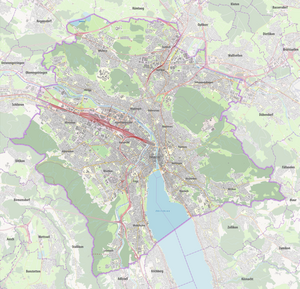Friesenberg Castle (Zurich)
| Friesenberg Castle | ||
|---|---|---|
|
Friesenberg Castle, portico |
||
| Creation time : | 11th century | |
| Castle type : | Höhenburg, spur location | |
| Conservation status: | ruin | |
| Geographical location | 47 ° 21 '29.4 " N , 8 ° 29' 38.5" O | |
| Height: | 658 m above sea level M. | |
|
|
||
The castle Friesenberg is the ruin of a Spur castle in the Swiss Zurich , which was probably built in the 11th century. It was mentioned for the first time in 1218 in a description of the property of the Church of St. Peter as a landmark. It stands on the steep eastern slope of the Uetliberg high above the city.
location
The ruin lies on a terraced spur protected by a neck ditch , the Goldbrunnegg, at an altitude of 658 m above sea level. M. The place in the forest on the eastern flank of the Uetliberg was more than three kilometers away from the old town of Zurich - today it is not far from the Uetliberg cemetery in the Wiedikon district .
From a geographical point of view, Friesenberg Castle formed the extended end point of the advanced Letzi fortification line , but was not structurally integrated directly into the Zurich fortification line. Therefore, and also because of the feudal relationships at the time , the Friesenburg was probably used as a strategic fore of Regensberg Castle Uetliburg during the final settlement phase.
history
The history of Friesenberg Castle clearly reflects the changing power relations and the strengthening of the free cities in competition with the previously dominant aristocratic families in the 13th century - specifically the history of the city of Zurich , which was de facto granted imperial immediacy as early as 1219 by Frederick II received and the barons of Regensberg .
A certificate from the County of Kyburg from 1257 names Jakob Mülner , the Meier of the Wiedikon court and Imperial Bailiff of Zurich, as the knight Jacobus Molendinarius de Vriesenberch . It is possible that Friesenberg Castle was administered as the Vorwerk of the Imperial Bailiwick of Zurich by a knight dynasty from the city of Zurich, the Mülner family, who were also owners of the Wiedikon castle and farm in the middle of the 13th century. In contrast, a list from 1321 lists Friesenberg as a fiefdom of the Barons of Regensberg and the Counts of Habsburg.
Similar to some of the other five castles on the Uetliberg, the destruction or abandonment of the actual castle complex can no longer be precisely determined. The Friesenburg is likely to have been abandoned or destroyed around 1300, as it was mentioned as a castle stable in a property register as early as 1317 .
The abandonment or destruction of the castle complex can therefore be assumed in connection with the increasing disputes between the House of Habsburg and the Barons of Regensberg - Regensberg feud of 1267/1268 or the "blood revenge of 1309" for the regicide of May 1, 1308 against Albrecht I. This would explain why in 1321 the Habsburg dynasty and the barons of Regensberg together, from 1344 on the Habsburgs alone should be named as owners of the Friesenburg. But it is also possible that Friesenberg Castle was not destroyed until the summer of 1383 (v. Wattenwyl, Geschichte von Bern).
In 1344 the castle site with the associated goods "for services rendered" became the property of the knightly family of Mayor Johannes Mülner, whose last descendant died in the battle of Sempach in 1386.
In 1387, the future Zurich guild master Johann Aeppli bought the castle property including the associated goods. In 1436 it was acquired by the Oetenbach Abbey , and after further changes of ownership in 1902, it became the property of the City of Zurich.
From 1925 to 1930, the ruins, including the outer wall was the main castle and the significantly remote from the main castle Sodbrunnen exposed. Due to the improper procedure from today's archaeological point of view and the archaeologically unsound conservation, the majority of the different layers of the find were destroyed, so that only guesses can be made about the original structure. The defensive wall could have an area enclosed by up to 30 to 18 meters (including Sodbrunnen), the square keep was around six meters on a side.
Even with the more romanticized reconstruction of the visible walls, it is said that little care was taken. The originally rather square floor plan of the keep became a trapezoid, a window and an archway (portico) are said to have been incorrectly inserted when the ruins were partially built.
swell
- Thomas Bitterli-Waldvogel: Swiss Castle Guide. Basel / Berlin 1995.
- Konrad Escher: Chronicle of the former communities Wiedikon and Aussersihl. Zurich City / Regina Druck Zurich 1911/1979.
- Fritz Hauswirth: Castles of Switzerland, Vol. 4: Cantons of Zurich and Schaffhausen. Kreuzlingen 1968 and 1979, Zurich 1982.
- Hugo Schneider: The castles and their inhabitants. In: Walter Drack u. a .: The Üetliberg. Silva, Zurich 1984, 2nd edition Orell Füssli, Zurich 1986.
- Emil Stauber: The castles and noble families of the districts of Zurich, Affoltern and Horgen. Birkhäuser, Basel 1955.
- H. Zeller-Werdmüller: Zurich castles. In: Announcements of the Antquarian Society in Zurich, 48./49. Born 1894–1895.






